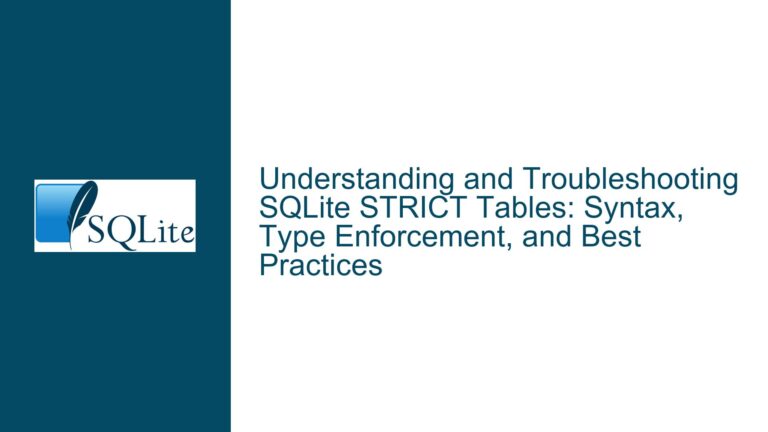Enforcing Conditional Uniqueness in SQLite for Furniture Room Allocation
Issue Overview: Unique Constraint Applicable Only When a Flag is Active
The core challenge involves implementing a database schema in SQLite where certain records must adhere to a uniqueness constraint only when a specific boolean flag (e.g., unique_type) is enabled. In the provided scenario, furniture items within a room must be unique per type if they are marked as unique_type (e.g., a single "table" per room), while non-unique types (e.g., "chairs") can have multiple entries.
This requirement introduces two critical constraints:
- Conditional Uniqueness: Enforcing uniqueness on the combination of
roomandtypeonly whenunique_typeisTRUE. - Data Integrity: Ensuring that the
unique_typeflag is consistently applied across all relevant records and that invalid data (e.g., duplicate unique-type items in the same room) cannot be inserted.
SQLite lacks direct support for conditional uniqueness constraints in table definitions. However, the problem is solvable through partial indexes, normalized table structures, and trigger-based validation. Missteps in schema design or constraint implementation can lead to silent data corruption, unintended duplicates, or runtime constraint violations.
Possible Causes: Why Conditional Uniqueness Might Fail
1. Inadequate Use of Partial Indexes
A common mistake is attempting to enforce uniqueness through a standard UNIQUE constraint on columns like room and type, which would incorrectly apply to all records, regardless of the unique_type flag. Without a mechanism to restrict the uniqueness check to only rows where unique_type = TRUE, the constraint becomes overly restrictive and invalidates legitimate duplicates for non-unique furniture types.
2. Lack of Normalization Leading to Ambiguity
Storing denormalized data (e.g., room names and furniture types as free-text strings) introduces risks of case sensitivity mismatches (e.g., "Living room" vs. "Living Room") or typographical variations. This can bypass uniqueness checks because SQLite’s default collation treats text as case-insensitive only if explicitly configured. Without normalized reference tables for rooms and furniture types, the system cannot reliably enforce uniqueness at the semantic level.
3. Trigger or View Logic Errors
When using views and INSTEAD OF triggers to abstract a normalized schema into a denormalized interface, improper trigger logic can fail to propagate data correctly. For example, inserting into a view that joins multiple tables might not correctly resolve foreign keys or enforce the unique_type flag from the underlying tables, leading to inconsistent data states.
4. Missing Check Constraints on Flags
If the unique_type column allows values outside the intended range (e.g., integers other than 0 or 1), invalid data could disrupt partial index logic. A missing CHECK constraint on this column could permit erroneous flag values, causing the partial index to either over-enforce or under-enforce uniqueness.
5. Collation Conflicts in Text-Based Columns
Uniqueness checks on text columns (e.g., room or type) using case-sensitive collation might allow duplicates that differ only in letter case. For example, "Table" and "table" would be considered distinct unless the columns use COLLATE NOCASE or a case-insensitive collation is enforced.
Troubleshooting Steps, Solutions & Fixes
Step 1: Implement Partial Indexes for Conditional Uniqueness
Solution:
Use SQLite’s partial unique indexes to enforce uniqueness on a subset of rows defined by a WHERE clause. This ensures that only rows meeting the unique_type = TRUE condition are included in the uniqueness check.
Implementation:
CREATE TABLE furniture (
room TEXT NOT NULL COLLATE NOCASE,
type TEXT NOT NULL COLLATE NOCASE,
unique_type INTEGER NOT NULL CHECK (unique_type IN (0, 1))
);
CREATE UNIQUE INDEX idx_unique_furniture
ON furniture(room, type)
WHERE unique_type = 1;
Breakdown:
- The
CHECKconstraint ensuresunique_typecan only be0(false) or1(true). - The partial index
idx_unique_furnitureenforces uniqueness onroomandtypeonly for rows whereunique_type = 1. COLLATE NOCASEonroomandtypeprevents case-sensitive duplicates (e.g., "Table" vs. "table").
Verification:
-- Succeeds (non-unique type)
INSERT INTO furniture (room, type, unique_type) VALUES ('Kitchen', 'Chair', 0);
INSERT INTO furniture (room, type, unique_type) VALUES ('Kitchen', 'Chair', 0);
-- Fails (unique type violation)
INSERT INTO furniture (room, type, unique_type) VALUES ('Kitchen', 'Table', 1);
INSERT INTO furniture (room, type, unique_type) VALUES ('Kitchen', 'Table', 1); -- Error: UNIQUE constraint failed
Step 2: Normalize Schema to Eliminate Ambiguity
Problem:
Storing room and type as free-text strings in the furniture table risks duplicates due to spelling variations or inconsistent casing.
Solution:
Create reference tables for Rooms and FurnitureTypes, then link them via a junction table Furnishings. This ensures referential integrity and consistent casing.
Implementation:
CREATE TABLE Rooms (
room_id INTEGER PRIMARY KEY,
room_name TEXT NOT NULL UNIQUE COLLATE NOCASE
);
CREATE TABLE FurnitureTypes (
type_id INTEGER PRIMARY KEY,
type_name TEXT NOT NULL UNIQUE COLLATE NOCASE,
is_unique INTEGER NOT NULL CHECK (is_unique IN (0, 1))
);
CREATE TABLE Furnishings (
room_id INTEGER NOT NULL REFERENCES Rooms(room_id),
type_id INTEGER NOT NULL REFERENCES FurnitureTypes(type_id),
custom_name TEXT COLLATE NOCASE,
-- Additional columns as needed
UNIQUE (room_id, type_id) WHERE is_unique = 1 -- Not valid syntax; see Step 3
);
Issue:
SQLite does not allow WHERE clauses in UNIQUE constraints within CREATE TABLE. Instead, apply the partial index to the Furnishings table.
Fix:
CREATE UNIQUE INDEX idx_unique_furnishings
ON Furnishings(room_id, type_id)
WHERE is_unique = 1;
Normalization Workflow:
- Insert Rooms and FurnitureTypes First:
INSERT INTO Rooms (room_name) VALUES ('Living Room'), ('Kitchen'); INSERT INTO FurnitureTypes (type_name, is_unique) VALUES ('Table', 1), ('Chair', 0); - Insert Furnishings with Foreign Keys:
INSERT INTO Furnishings (room_id, type_id, custom_name) VALUES (1, 1, 'Dining Table'), -- Succeeds (unique type) (1, 2, 'Bar Stool 1'), -- Succeeds (non-unique type) (1, 2, 'Bar Stool 2'); -- Succeeds (non-unique type) - Attempt Duplicate Unique Type:
INSERT INTO Furnishings (room_id, type_id, custom_name) VALUES (1, 1, 'Coffee Table'); -- Fails: Partial index enforces uniqueness
Step 3: Automate Flag Propagation with Triggers
Problem:
The is_unique flag is stored in FurnitureTypes, but the Furnishings table must respect this flag when inserting records. Manually setting is_unique during insertion is error-prone.
Solution:
Use a BEFORE INSERT trigger to automatically set is_unique in Furnishings based on the corresponding FurnitureTypes entry.
Implementation:
CREATE TRIGGER trg_furnishings_set_unique
BEFORE INSERT ON Furnishings
BEGIN
UPDATE Furnishings
SET is_unique = (
SELECT is_unique
FROM FurnitureTypes
WHERE type_id = NEW.type_id
)
WHERE room_id = NEW.room_id AND type_id = NEW.type_id;
END;
Optimization:
To avoid redundant updates, directly set is_unique during insertion using a subquery:
CREATE TRIGGER trg_furnishings_set_unique
BEFORE INSERT ON Furnishings
FOR EACH ROW
BEGIN
SELECT RAISE(ABORT, 'Invalid type_id')
WHERE NOT EXISTS (
SELECT 1 FROM FurnitureTypes WHERE type_id = NEW.type_id
);
UPDATE Furnishings
SET is_unique = (
SELECT is_unique
FROM FurnitureTypes
WHERE type_id = NEW.type_id
)
WHERE room_id = NEW.room_id AND type_id = NEW.type_id;
END;
Verification:
INSERT INTO Furnishings (room_id, type_id, custom_name)
VALUES (1, 1, 'Dining Table'); -- is_unique automatically set to 1
Step 4: Abstract Complexity with Views and INSTEAD OF Triggers
Problem:
Direct interaction with normalized tables (Rooms, FurnitureTypes, Furnishings) can be cumbersome. Users may prefer a denormalized view resembling the original furniture table.
Solution:
Create a view FurnishingsView that joins all three tables and use INSTEAD OF triggers to handle inserts, updates, and deletes through the view.
Implementation:
Create View:
CREATE VIEW FurnishingsView AS SELECT r.room_name AS room, ft.type_name AS type, f.custom_name, ft.is_unique FROM Furnishings f JOIN Rooms r ON f.room_id = r.room_id JOIN FurnitureTypes ft ON f.type_id = ft.type_id;INSTEAD OF INSERT Trigger:
CREATE TRIGGER trg_furnishings_view_insert INSTEAD OF INSERT ON FurnishingsView BEGIN -- Insert or ignore new rooms INSERT OR IGNORE INTO Rooms (room_name) VALUES (NEW.room); -- Insert or ignore new furniture types INSERT OR IGNORE INTO FurnitureTypes (type_name, is_unique) VALUES (NEW.type, NEW.is_unique); -- Insert into Furnishings INSERT INTO Furnishings (room_id, type_id, custom_name) SELECT (SELECT room_id FROM Rooms WHERE room_name = NEW.room), (SELECT type_id FROM FurnitureTypes WHERE type_name = NEW.type), NEW.custom_name; END;INSTEAD OF DELETE Trigger:
CREATE TRIGGER trg_furnishings_view_delete INSTEAD OF DELETE ON FurnishingsView BEGIN DELETE FROM Furnishings WHERE room_id = (SELECT room_id FROM Rooms WHERE room_name = OLD.room) AND type_id = (SELECT type_id FROM FurnitureTypes WHERE type_name = OLD.type) AND custom_name = OLD.custom_name; END;
Usage Example:
-- Insert via view
INSERT INTO FurnishingsView (room, type, custom_name, is_unique)
VALUES ('Living Room', 'Table', 'Center Table', 1);
-- Delete via view
DELETE FROM FurnishingsView
WHERE room = 'Living Room' AND type = 'Table' AND custom_name = 'Center Table';
Step 5: Validate Collation and Case Sensitivity
Problem:
Uniqueness checks may fail to account for case differences (e.g., "living room" vs. "Living Room") if collation is not configured properly.
Solution:
Apply COLLATE NOCASE to all text columns involved in uniqueness checks.
Implementation:
CREATE TABLE Rooms (
room_id INTEGER PRIMARY KEY,
room_name TEXT NOT NULL UNIQUE COLLATE NOCASE
);
CREATE TABLE FurnitureTypes (
type_id INTEGER PRIMARY KEY,
type_name TEXT NOT NULL UNIQUE COLLATE NOCASE,
is_unique INTEGER NOT NULL CHECK (is_unique IN (0, 1))
);
Verification:
INSERT INTO Rooms (room_name) VALUES ('living room');
INSERT INTO Rooms (room_name) VALUES ('Living Room'); -- Fails: UNIQUE constraint
Step 6: Handle Edge Cases and Conflicts
Case 1: Updating unique_type After Insertion
If a furniture type’s is_unique flag is updated from 0 to 1, existing duplicates in Furnishings will violate the partial index.
Solution:
Prevent updates to is_unique if conflicting data exists:
CREATE TRIGGER trg_prevent_unsafe_unique_update
BEFORE UPDATE OF is_unique ON FurnitureTypes
FOR EACH ROW
WHEN NEW.is_unique = 1 AND OLD.is_unique = 0
BEGIN
SELECT RAISE(ABORT, 'Cannot enable is_unique: duplicates exist')
WHERE EXISTS (
SELECT 1
FROM Furnishings
WHERE type_id = NEW.type_id
GROUP BY room_id, type_id
HAVING COUNT(*) > 1
);
END;
Case 2: Deleting Orphaned Rooms or Furniture Types
When deleting entries from Furnishings, ensure that orphaned rooms or furniture types are also removed.
Solution:
Use AFTER DELETE triggers on Furnishings:
CREATE TRIGGER trg_cleanup_rooms
AFTER DELETE ON Furnishings
FOR EACH ROW
BEGIN
DELETE FROM Rooms
WHERE room_id = OLD.room_id
AND NOT EXISTS (
SELECT 1 FROM Furnishings WHERE room_id = OLD.room_id
);
END;
CREATE TRIGGER trg_cleanup_furniture_types
AFTER DELETE ON Furnishings
FOR EACH ROW
BEGIN
DELETE FROM FurnitureTypes
WHERE type_id = OLD.type_id
AND NOT EXISTS (
SELECT 1 FROM Furnishings WHERE type_id = OLD.type_id
);
END;
Final Recommendations
- Prefer Normalized Schemas: They reduce redundancy and prevent data anomalies.
- Use Partial Indexes Judiciously: They are powerful but require careful condition design.
- Leverage Triggers for Complex Logic: Automate data integrity checks and flag propagation.
- Test Collation Settings: Ensure case insensitivity where required.
- Implement Comprehensive Constraints: Use
CHECK,FOREIGN KEY, andUNIQUEconstraints liberally.
By following these steps, you can enforce conditional uniqueness in SQLite while maintaining data integrity and usability.






